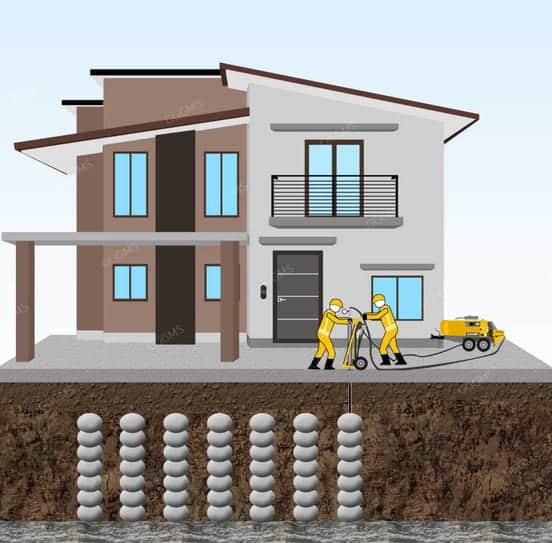Methods Used To Rectify a Leaned Building or Structure
There are several reasons that may cause a building to settle or lean excessively. For instance, soil liquefaction after an earthquake, variation in groundwater conditions, construction defects, inappropriate foundation, or excavation can cause a building to settle or lean.

Image source: gggms.com/services/compaction-grouting/
When a structure is settled or leaned, it’s important to lift it to ensure it regains its stability and prevent calamities. There are several techniques used in uplifting such buildings. They include:
- Underpinning
- Micro-tunneling
- Compaction grouting
- Chemical grouting
-
Underpinning
Underpinning is a technique used in restoring a tilted structure to make it vertical. Underpinning is also used in rectifying a structure that is constructed on a mat foundation or an individual footing. It’s more expensive than chemical grouting and compaction grouting techniques.
Underpinning involves excavating around an existing foundation to insert underpinning piles and lift the building. Upon excavation, jacks are inserted between the pile cap and the foundation to lift up the structure.
Next, the load on the foundation is transferred to the new underpins. However, improper design of the underpinning process may cause further settlement and unstableness of the building. Thus, it should be done by an experienced and professional underpinning contractor.
-
Micro-Tunneling
Micro-tunneling is used in rectifying a building that’s built on a cohesive soil such that it’s leaning a little bit. That way, it’s more practical to create some deformations beneath the side that is less settled with the help of micro tunnels.
Generally, micro-tunneling is done through drilling small holes beneath the less settled part of the building. The holes are thereafter deformed as a result of the overlying load.
Consequently, the holes collapse under the load such that the surface slides. The foundation will rotate and sit opposite the inclination.
-
Compaction Grouting
Compaction grouting is used to fix a building that has settled or tiled excessively. The technique requires detailed planning and preparation before working on the affected structure.
For instance, it’s necessary to determine the grouting pressure, grouting rate, grouting depth, the method for executing the task, and configurations of the grouting stations.
It’s necessary to ensure the structure is equipped with enough monitoring devices. The devices observe the ongoing process and assist in making necessary changes when lifting is ongoing.
Compaction grouting is done through two methods which are either digging holes from a certain side of a structure or making holes through the slab vertically.
The function offered by the building may face disruption during the compaction grouting process. Digging holes from the side of a structure won’t affect the functionality of the building but is not as effective as making holes through the slab vertically.
It’s advisable to concentrate the grouting stations over the sections that have settled the most. The major grout injection points are arranged in the deepest section.
The minor grout injection points are arranged on the areas where the depth is smallest and the locations that have settled the least.
The compaction grouting process starts at the major grout injection points and proceeds to the minor grout injection points. In case the structure has settled excessively, the process is typically done in several stages.
-
Chemical Grouting
This technique is used in restoring a tilted structure to its initial position. It’s an economical method but requires special attention for the best results. If this process is done improperly, there may be unwanted grout flow that may cause structural and pipe damages.
Just like compaction grouting, it’s necessary to ensure that there’s a detailed plan before doing the work. Also, it’s necessary to ensure proper grouting pressure and configuration of the injection points.
Also, keep measures in place that will prevent the grout from flowing before starting the process.
Determining the arrangement of the injection points, the amount of grouting to be injected, and the grouting pressure depends on the observation acquired from the monitoring devices.
Grout flow can be prevented by placing sheet piles within the range of grouting or by reducing the time required for grout to set.
Also read: Underpinning and Shoring in Building Construction


